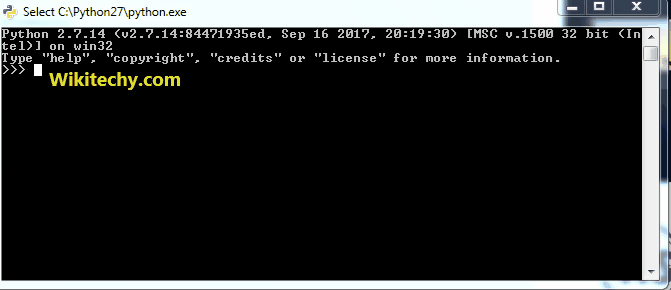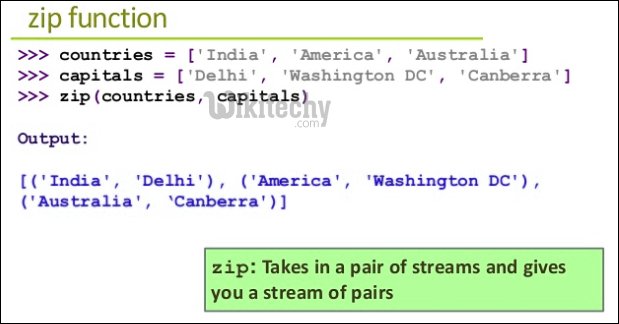
Learn Python - Python tutorial - python iterations - Python examples - Python programs
Following are different ways to use iterators.
python - Sample - python code :
# A C-style way of accessing list elements
cars = ["Aston", "Audi", "McLaren"]
i = 0
while (i < len(cars)):
print cars[i]
i += 1python tutorial - Output :
Aston Audi McLaren
Important Points:
- This style of looping is rarely used by python programmers.
- This 4-step approach creates no compactness with single-view looping construct.
- This is also prone to errors in large-scale programs or designs.
- There is no C-Style for loop in Python, i.e., a loop like for (int i=0; i<n; i++)
This style is used in python containing iterator of lists, dictonary, n dimensional-arrays etc. The iterator fetches each component and prints data while looping. The iterator is automatically incremented/decremented in this construct.
python - Sample - python code :
# Accessing items using for-in loop
cars = ["Aston", "Audi", "McLaren"]
for x in cars:
print xpython tutorial - Output :
Aston Audi McLaren
Indexing using Range function: We can also use indexing using range() in Python.
python - Sample - python code :
# Accessing items using indexes and for-in
cars = ["Aston", "Audi", "McLaren"]
for i in range(len(cars)):
print cars[i]python tutorial - Output :
Aston Audi McLaren
Enumerate is built-in python function that takes input as iterator, list etc and returns a tuple containing index and data at that index in the iterator sequence. For example, enumerate(cars), returns a iterator that will return (0, cars[0]), (1, cars[1]), (2, cars[2]), and so on.
python - Sample - python code :
# Accessing items using enumerate()
cars = ["Aston" , "Audi", "McLaren "]
for i, x in enumerate(cars):
print (x)python tutorial - Output :
Aston Audi McLaren
Below solution also works.
python - Sample - python code :
# Accessing items and indexes enumerate()
cars = ["Aston" , "Audi", "McLaren "]
for x in enumerate(cars):
print (x[0], x[1])python tutorial - Output :
(0, 'Aston') (1, 'Audi') (2, 'McLaren ')
We can also directly print returned value of enumerate() to see what it returns.
python - Sample - python code :
# Printing return value of enumerate()
cars = ["Aston" , "Audi", "McLaren "]
print enumerate(cars)python tutorial - Output :
[(0, 'Aston'), (1, 'Audi'), (2, 'McLaren ')]
Enumerate takes parameter start which is default set to zero. We can change this parameter to any value we like. In the below code we have used start as 1.
python - Sample - python code :
# demonstrating use of start in enumerate
cars = ["Aston" , "Audi", "McLaren "]
for x in enumerate(cars, start=1):
print (x[0], x[1])python tutorial - Output :
(1, 'Aston') (2, 'Audi') (3, 'McLaren ')
enumerate() helps to embed solution for accessing each data item in iterator and fetching index of each data item.
i) Two iterators for a single looping construct: In this case, a list and dictionary are to be used for each iteration in a single looping block using enumerate function. Let us see example.
python - Sample - python code :
# Two separate lists
cars = ["Aston", "Audi", "McLaren"]
accessories = ["GPS kit", "Car repair-tool kit"]
# Single dictionary holds prices of cars and
# its accessories.
# First two items store prices of cars and
# next three items store prices of accessories.
prices = {1:"570000$", 2:"68000$", 3:"450000$",
4:"890000$", 5:"4500$"}
# Printing prices of cars
for index, c in enumerate(cars, start=1):
print "Car: %s Price: %s"%(c, prices[index])
# Printing prices of accessories
for index, a in enumerate(accessories,start=1):
print ("Accessory: %s Price: %s"\
%(a,prices[index+len(cars)]))
python tutorial - Output :
Car: Aston Price: 570000$ Car: Audi Price: 68000$ Car: McLaren Price: 450000$ Accessory: GPS kit Price: 890000$ Accessory: Car repair-tool kit Price: 4500$
ii) zip function (Both iterators to be used in single looping construct):
This function is helpful to combine similar type iterators(list-list or dict- dict etc) data items at ith position. It uses shortest length of these input iterators. Other items of larger length iterators are skipped. In case of empty iterators it returns No output.

For example, the use of zip for two lists (iterators) helped to combine a single car and its required accessory.
python - Sample - python code :
# Python program to demonstrate working of zip
# Two separate lists
cars = ["Aston", "Audi", "McLaren"]
accessories = ["GPS", "Car Repair Kit",
"Dolby sound kit"]
# Combining lists and printing
for c, a in zip(cars, accessories):
print "Car: %s, Accessory required: %s"\
%(c, a)python tutorial - Output :
Car: Aston, Accessory required: GPS Car: Audi, Accessory required: Car Repair Kit Car: McLaren, Accessory required: Dolby sound kit
The reverse of getting iterators from zip function is known as unzipping using “*” operator.
Use of enumerate function and zip function helps to achieve an effective extension of iteration logic in python and solves many more sub-problems of a huge task or problem.

python - Sample - python code :
# Python program to demonstrate unzip (reverse
# of zip)using * with zip function
# Unzip lists
l1,l2 = zip(*[('Aston', 'GPS'),
('Audi', 'Car Repair'),
('McLaren', 'Dolby sound kit')
])
# Printing unzipped lists
print(l1)
print(l2)python tutorial - Output :
('Aston', 'Audi', 'McLaren')
('GPS', 'Car Repair', 'Dolby sound kit')
